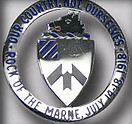

The Third Infantry Division in WWII
The 3rd Division is one of the few American divisions that fought the Axis on all European fronts during World War II, and was among the first U.S. combat units to engage in offensive ground combat operations. It saw combat in North Africa, Sicily, Italy, France, Germany and Austria for 531 consecutive days.
The division first saw action as a part of the Western Task Force in the invasion of North Africa, landing at Fedala on 8 November 1942, and captured half of French Morocco. Eight months later, on 10 July 1943, the division made an assault landing on Sicily, Licata town on the beach, to west, called Torre di Gaffi and Mollarella and on the beach, to east, called Falconara. Fought its way into Palermo before the armor could get there, and raced on to capture Messina, thus ending the Sicilian campaign.
Nine days after the invasion of mainland Italy, on 18 September 1943, the 3rd landed at Salerno. Seeing intensive action along the way, the division drove to and across the Volturno River by October 1943, and then to Cassino, where the battle of Monte Cassino would later be fought. After a brief rest, the division was part of the amphibious landing at Anzio, 22 January 1944, as part of VI Corps of British and American units. It would remain there for four months in a toe-hold against furious German counterattacks.
On 29 February 1944, the 3rd fought off an attack by three German divisions. In a single day of combat at Anzio, the 3rd Infantry Division suffered more than 900 casualties, the most of any U.S. division on one day in World War II. The division's former commander, John P. Lucas, was replaced as head of VI Corps by the 3rd Division's then-commander Lucian Truscott.
In late May, VI Corps broke out of the beachhead with the 3rd Division in the main thrust. Instead of defeating the Germans, Clark sent the division on to Rome. This allowed the enemy forces, which would otherwise have been trapped, to escape. The division was then removed from the front line and went into training for Operation Dragoon … the invasion of Southern France.
On 15 August 1944, D-Day for Dragoon, the division landed at St. Tropez, advanced up the Rhone Valley, through the Vosges Mountains, and reached the Rhine at Strasbourg, 26–27 November 1944. After maintaining defensive positions it took part in clearing the Colmar Pocket on 23 January, and on 15 March struck against Siegfried Line positions south of Zweibrücken. The division advanced through the defenses and crossed the Rhine, 26 March 1945; then drove on to take Nuremberg in a fierce battle, capturing the city in block-by-block fighting, 17–20 April. The 3rd pushed on to take Augsburg and Munich, 27–30 April, and was in the vicinity of Salzburg when the war in Europe ended. Elements of the 7th Infantry Regiment serving in the 3rd Infantry Division captured Hitler's retreat at Berchtesgaden in May 1945.
During World War II the 3rd Infantry Division earned 42 Medals of Honor … more than any other Division in the Second World War. It suffered 4,922 killed in action, 18,766 wounded and with a further 636 who died of wounds.
The Division’s battle honors for World War II include:
Algeria-French Morocco ∆
Tunisia
Sicily ∆
Naples-Foggia
Anzio ∆
Rome-Arno
Southern France ∆
Rhineland
Ardennes-Alsace
Central Europe
∆ - Indicate arrowhead device for amphibious assault landing
Units organic to the 3rd Infantry Division
Headquarters & Headquarters Company
7th Infantry Regiment
15th Infantry Regiment
30th Infantry Regiment
3d Infantry Division Artillery
9th Field Artillery Battalion
10th Field Artillery Battalion
39th Field Artillery Battalion
41st Field Artillery Battalion
3d Reconnaissance Troop
10th Engineer Combat Battalion
3d Medical Battalion
3d Signal Company
3d Quartermaster Company
703d Ordnance Company
3d Infantry Division Band
44lst Antiaircraft Artillery Battalion
601st Tank Destroyer Battalion
756th Tank Battalion



